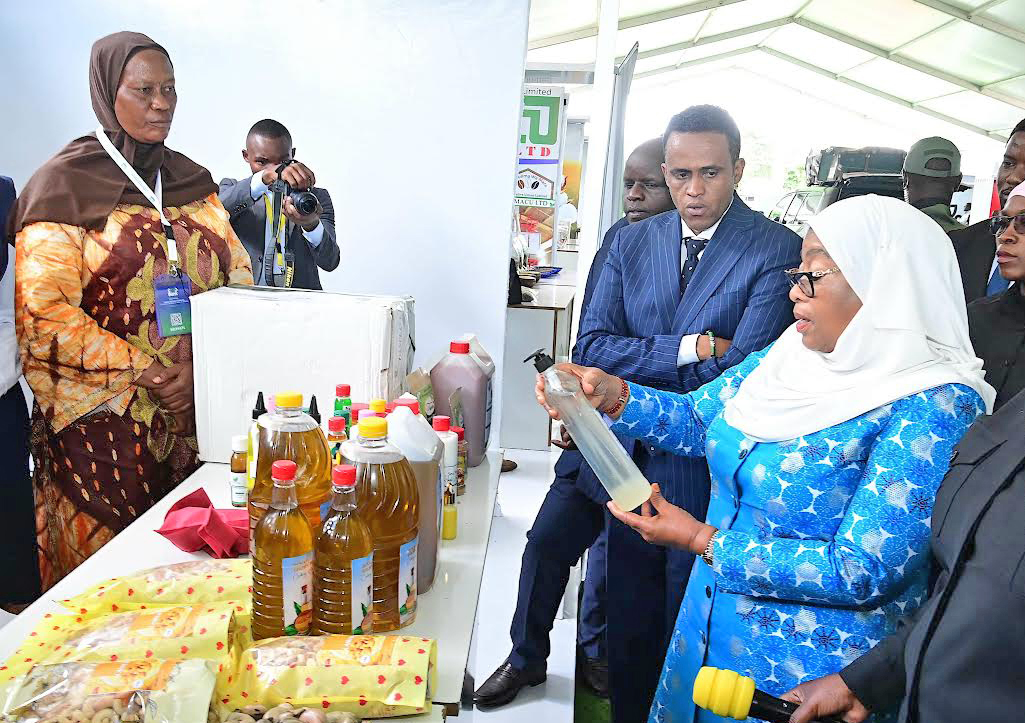Ministry highlights major feats in agriculture in past four years

Chairman of the Parliamentary Committee on Industry, Trade, Agriculture and Livestock, Deodatus Mwanyika presents to the parliament the committee’s opinion on the estimated revenue and expenditure of the ministry of Agriculture for the financial year 2025, in Dodoma yesterday. PHOTO | Edwin Mjwahuzi
What you need to know:
- Bashe detailed the structural interventions that have transformed the sector, from expanding irrigation and cooperative systems to reducing import reliance and boosting exports
Dodoma. The ministry of Agriculture has outlined significant progress made in the sector over the past four years, driven by increased public investment, improved access to inputs, stronger research and extension services, and robust production growth.
Presenting the ministry’s Sh1.243 trillion budget for the 2025/26 financial year in parliament on Wednesday, Agriculture minister Hussein Bashe detailed the structural interventions that have transformed the sector, from expanding irrigation and cooperative systems to reducing import reliance and boosting exports.
Mr Bashe said the sixth phase government, which came into office in March 2021, inherited multiple challenges: limited funding, inadequate access to credit, lack of a dedicated agricultural development fund, unregulated farming practices, and minimal youth and women participation due to capital and land access constraints.
“Infrastructure for post-harvest storage was insufficient, cooperatives were weak, and markets were uncompetitive. We were still importing wheat, sugar, and edible oil due to inadequate local production,” he told parliament.
He also cited constraints such as volatile input prices worsened by the Covid-19 pandemic, delays at Dar es Salaam Port, insufficient extension services and equipment, poor pest and disease control capacity, low fertiliser output, and a shortage of irrigation expertise. “These challenges collectively undermined productivity, export performance, food security, and access to finance—leaving many farmers in poverty,” said Mr Bashe.
He noted that the ruling CCM’s 2020 election manifesto had prioritised strengthening voluntary cooperatives under government oversight, modernising irrigation, enhancing research and extension services, improving market access, and creating self-employment for youth.
President Samia Suluhu Hassan reinforced these priorities in her inaugural speech to Parliament in April 2021, calling for urgent action to boost crop productivity through research, seed production, irrigation expansion, and improved access to inputs.
Budget and sectoral performance
Mr Bashe reported that reaching April 2025, the ministry’s budget increased by 324.5 percent—from Sh294 billion in 2021/22 to Sh1.248 trillion in 2024/25.
He said sectoral growth also improved—from 2.6 percent in 2021 to 4.2 percent in 2023, with projections of five percent by 2025 and 10 percent by 2030.
“The value of agricultural exports rose from $1.2 billion in 2019/20 to $3.54 billion in 2023/24—a 195 percent increase,” he said.
Food crop production grew by 33 percent from 17.14 million tonnes in 2021/22 to 22.8 million tonnes in 2023/24, reaching 128 percent food self-sufficiency—close to the 130 percent national target.
Maize production increased by 91 percent to 12.26 million tonnes, positioning Tanzania as Africa’s second-largest maize producer, while rice production rose by 72 percent to 3.04 million tonnes over the same period.
Surged cash crop production
Mr Bashe said the output grew by 61.5 percent from 898,967 tonnes in 2020/21 to 1.45 million tonnes in 2023/24.
He said while cashew nut production rose 151 percent to 528,263 tonnes, and tobacco output climbed 173 percent to 160,000 tonnes, making Tanzania the second-largest producer on the continent. “Sugarcane production increased by 17 percent to 4.71 million tonnes, generating 431,736 tonnes of sugar—81.7 percent of the national requirement,” he said. Furthermore, he said sisal production rose by 69 percent, and coffee yields grew by 37 percent to 81,366 tonnes, ranking Tanzania fourth in Africa. According to him, domestic production of quality seeds more than doubled, rising by 111 percent to 63,526 tonnes.
“Avocado exports expanded by 131 percent to 35,627 tonnes, making Tanzania the third-largest avocado producer in Africa,” he said. He said oilseed production rose by 25 percent to 2.14 million tonnes, with sunflower output soaring by 154 percent to 1.21 million tonnes.
Fertiliser production and use
He said the country’s fertiliser production rose by 392 percent—from 32,239 tonnes to 158,628 tonnes—supported by the opening of a new plant in Dodoma and expanded capacity at Minjingu.
Mr Bashe said access to fertiliser increased by 79 percent to 1.21 million tonnes, with 1.45 million tonnes subsidised at a cost of Sh708.62 billion over three years.
Fertiliser usage, according to him, rose by 133 percent to 848,884 tonnes, while average use per hectare climbed from 19 kilogrammes to 24 kilogrammes—48 percent of the Comprehensive Africa Agriculture Development Programme (CAADP) target of 50 kilogrammes per hectare.
Food reserves and irrigation
The minister said national food reserve capacity grew by over 209 percent, from 251,000 tonnes in 2020/21 to 776,000 tonnes in 2024/25.
The number of irrigation projects increased from 13 in 2020/21 to 780 in 2024/25, covering 543,366 hectares at a total cost of Sh1.34 trillion.
Feasibility study is underway on 114 dam projects, two are complete, 19 under construction, 28 announced, and 65 in design. Total capacity stands at around 1.18 billion cubic metres.
He said upon completion, the irrigated area will expand to 1.27 million hectares, hinting that registered irrigation cooperatives rose from 19 to 912. “To support this expansion, 121 district offices were established, 344 staff recruited, and critical equipment—including 30 machines, 17 heavy vehicles, and 18 borehole rigs—was procured,” he said.
Research, extension and echanization
Furthermore, he said the ministry established several research and diagnostic facilities, including the National Biological Control Unit in Kibaha, a fertiliser regulatory lab in Dar es Salaam, and new labs at the Tanzania Agriculture Research Institute (TARI) Mlingano and the Tea Research Institute of Tanzania (TRIT)—all now internationally certified.
“To improve extension services, the ministry distributed 44 vehicles, 6,444 motorcycles, 143 soil health kits, 5,426 tablets, 1,662 toolkits, and constructed 50 houses for extension officers,” he said.
In terms of mechanisation, he said 500 tractors and 800 power tillers were acquired and a grape processing plant with a 300-tonne annual capacity was completed in Dodoma, along with a post-harvest management hub in Mtanana.
Job creation and crop inputs
Agriculture-related development projects created over 1.08 million direct and indirect jobs, including in irrigation and research, according to him.
He said the ministry distributed 109,083 tonnes of powdered and 8.82 million litres of liquid cashew pesticides, 6,337 sprayers, and inputs worth Sh556.7 billion for cashew.
According to him, Sh607.3 billion worth tobacco inputs and Sh325.4 billion valued for cotton were also distributed to farmers.
Cooperative development
He said the Tanzania Cooperative Bank was established with Sh58 billion capital, and has opened four branches—in Dodoma, Kilimanjaro, Tabora, and Mtwara and that fifty-eight apex cooperatives have been registered as agents of the bank.
Mr Bashe said the government also distributed 3,760 digital scales worth Sh13.3 billion to 992 cooperatives to promote transparency in crop purchasing.
“Employment within cooperatives increased by 55 percent, from 100,100 to 155,106, while the number of cooperative-owned processing facilities rose from 267 to 331,” he said.
“Savings within Savings and Credit Cooperative Societies (Saccos) grew from Sh576 billion to Sh966.9 billion, while loans disbursed to members increased from Sh798 billion to Sh1.1 trillion and clean audit reports rose from 339 to 631 cooperatives over the period,” added Mr Bashe.
Policy and legal reforms
Mr Bashe said the Tanzania Agriculture Master Plan 2050 was finalised, outlining strategic development goals over the short, medium, and long term.
He said four agricultural development corridors have been established and are being overseen by the Agricultural Transformation Office (ATO), and key sector laws have also been reviewed and amended to align with emerging needs.




